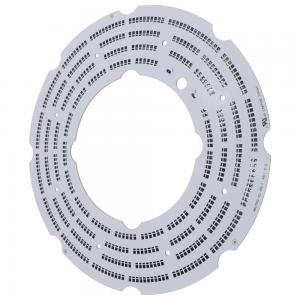

Add to Cart
Min Line Spacing 0.15mm LED Controller PCB Diode Circuit Board
Rohs Led Aluminum Lamp Pcb Round Led Pcb Board Used For Led Light
Advantages of Aluminum PCBs:
Use of Aluminum PCBs offers several advantages over that of regular
FR-4 PCBs. Compared to standard FR-4 constructions, the Aluminum
PCBs offer a dramatically superior heat dissipation. Although only
a tenth of the thickness of conventional epoxy-glass, the
dielectrics in an Aluminum PCB can be 5 to 10 times more conductive
thermally. This makes thermal management in Aluminum PCBs
exponentially more efficient compared to that of a conventional
rigid PCB. Therefore, designers can use lower copper weights in
Aluminum PCBs than those suggested by IPC in their heat-rise
charts.
Different Types of Aluminum PCBs
Manufacturers have been successful in innovating different types of
Aluminum PCBs such as:
Flexible Aluminum PCBs: These use new flexible dielectrics
featuring Polyimide resin systems with ceramic fillers for
excellent electrical insulation, thermal conductivity, and
flexibility. The metal base uses flexible Aluminum such as 5754 or
similar. The combination produces a PCB that the user can bend into
place, but not use for regular flexing.
Hybrid Aluminum PCBs: These use a non-thermal material as the
sub-assembly, which the fabricator processes independently, and
then bonds to the Aluminum base using thermal materials. For
instance, a conventional 2- or 4-layer FR-4 PCB bonded to an
Aluminum base helps to improve heat dissipation and mechanical
rigidity.
Multi-Layer Aluminum PCBs: Fabricators make these from multiple
layers of thermally conductive dielectrics. The designer can place
one or more layers of circuits buried in the dielectrics, and use
blind and buried vias. However, these PCBs are not so effective in
transferring heat.
Through-Hole Aluminum PCBs: Prior to lamination, the fabricator
must pre-drill the Aluminum base, and back-fill it with dielectric
to form the core of a multi-layer PCB. This allows the fabricator
to laminate both sides of the Aluminum base with thermal materials
and PCB subassemblies. After lamination, the fabricator can drill
the assembly like drilling a conventional multilayer PCB, with
plated through holes passing through the clearances in the
Aluminum. This is the most complex construction of an Aluminum PCB.
Product Type | Round Led Pcb Board |
Maximum Panel size | 20"*24" (1170mm*600mm) |
Copper thickness | 0.5oz, 1oz, 2oz, 3oz and 4 oz |
Dielectric Thickness (to Substrate) | 0.4mm,0.6mm, 0.8mm, 1.0mm, 1.2mm, 1.5mm,2.0mm, 3.0mm and 3.2mm |
Finished Board Thickness | 0.4mm To 4.0mm |
Thickness Tolerance | +/-10% |
Aluminum Machining | Drilling,Tapping,Milling,Routing, Die-Punching,break-off tab available |
Min. Finish hole size | 0.25mm |
Max.working voltage | 2.5kVDC(0.075mm Dielectric), 3.75kVDC (0.15mm Dielectric) |
Min.Track Width | 0.2mm (8mils) |
Min.Track gap | 0.2mm (8mils) |
Min. SMD pad pitch | 0.2mm (8mils) |
Surface Finishing | HASL, HASL Leadfree, Immersion gold, Flash gold, OSP |
Soldermask color | White, Black, others Available |
Legend color | Black, White, others Available |
FAQ:
Q1. Can I have a sample order for led light?
A: Yes, we welcome sample order to test and check quality. Mixed samples are acceptable.
Q2: Do you have after-sales product servicing available for your customers?
A: Yes, for any quality problems Fulltronics will take our responsibility to solve it for you any time.
Q3: What kind of PCB file format can you accept for production?
A: Gerber, PROTEL 99SE, PROTEL DXP, POWER PCB, CAM350, GCCAM,
ODB+(.TGZ)
